Things You Never Knew About Food
Below you’ll find 20 fact cards showing interesting facts you never knew about food and drink. We’ve uncovered some unusual information so we understand if you want to share the news.
Healthy Food Facts

‘Bananas are berries, but strawberries aren’t!’
Are you ready to have your whole perspective on bananas blown out of the water? Bananas are actually part a berry. Why, you ask? Well, a fruit is defined by botanists as the part of a flowering plant that contains seeds which has developed from the ovary. Berries are fruits that stem from one flower with one ovary, normally having many seeds. Bananas fit this definition and you may be surprised to learn that tomatoes, cucumbers and kiwis are also considered to be berries! Ironically, blackberries, raspberries and strawberries, despite their names are not actually berries, they are classed as ‘aggregate fruits’.
The weirdness doesn’t stop there. You may think that bananas grow on trees. That’s common knowledge, right? Wrong. Banana ‘trees’ have no wood tissue in their stem, so they’re technically regarded as a herb. So, if you thought you’d been eating fruit from a tree this whole time, we regret to inform you, it’s a berry from a herb. Now, that’s a fruit fact worth knowing.
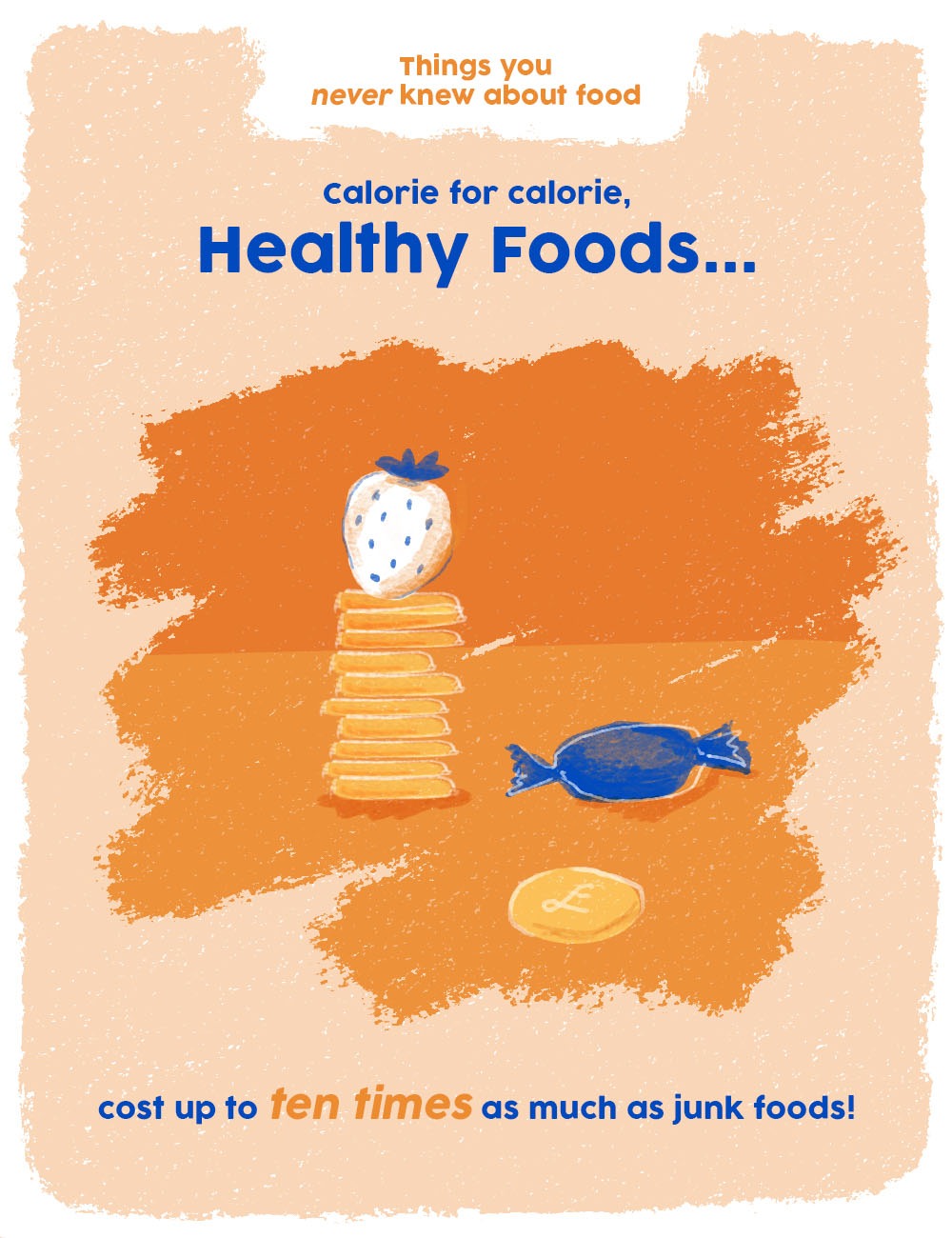
‘Calorie for calorie, healthy foods cost up to ten times as much as junk foods!’
This nutrition fact about junk food gives us some mixed feelings. The University of Washington did a study of 370 foods in supermarkets in Seattle and found that on average, healthy foods were ten times more expensive per 1,000 calories. This is an American-based study, but the same story applies over here in Europe.
Whenever we go shopping or walk down the high street, junk food is readily available and for cheap. The cost of junk food is less sensitive to inflation. The university’s findings showed that if you wanted to have a 2,000 calorie-a-day diet, it would cost you around $3.50 for each day if you consumed solely junk food. Doing the same with healthy food would cost you $36.
This nutrition fact should be as alarming as it is interesting. In the UK, we have seen levies being put on sugary drinks and fattening pastries. As delicious and often convenient as these foods are, Britain is facing an obesity crisis and we believe that healthy foods shouldn’t become a luxury item.

‘Mushrooms can’t be overcooked!’
Mushrooms contain a polymer called chitin in its cell walls. This structure allows for a tender taste whether you cook them for a few minutes or an hour. So, if you ruin your mushrooms next time you’re cooking, we regret to inform you that you’re just a bad cook.
Now, mushrooms are a type of fungi and there are some pretty crazy mushroom facts about fungi that we thought we’d also share with you. Related to the mushroom, a specific honey fungus is the largest living organism on Earth checking in at over 2.4 miles across. Speaking of relation to mushrooms, there is evidence to suggest that humans may have evolved from fungi. Animals separated from fungi around 1.5 billion years ago so humans were very much not a thing back then but still, that’s a head-scratcher of a fact.
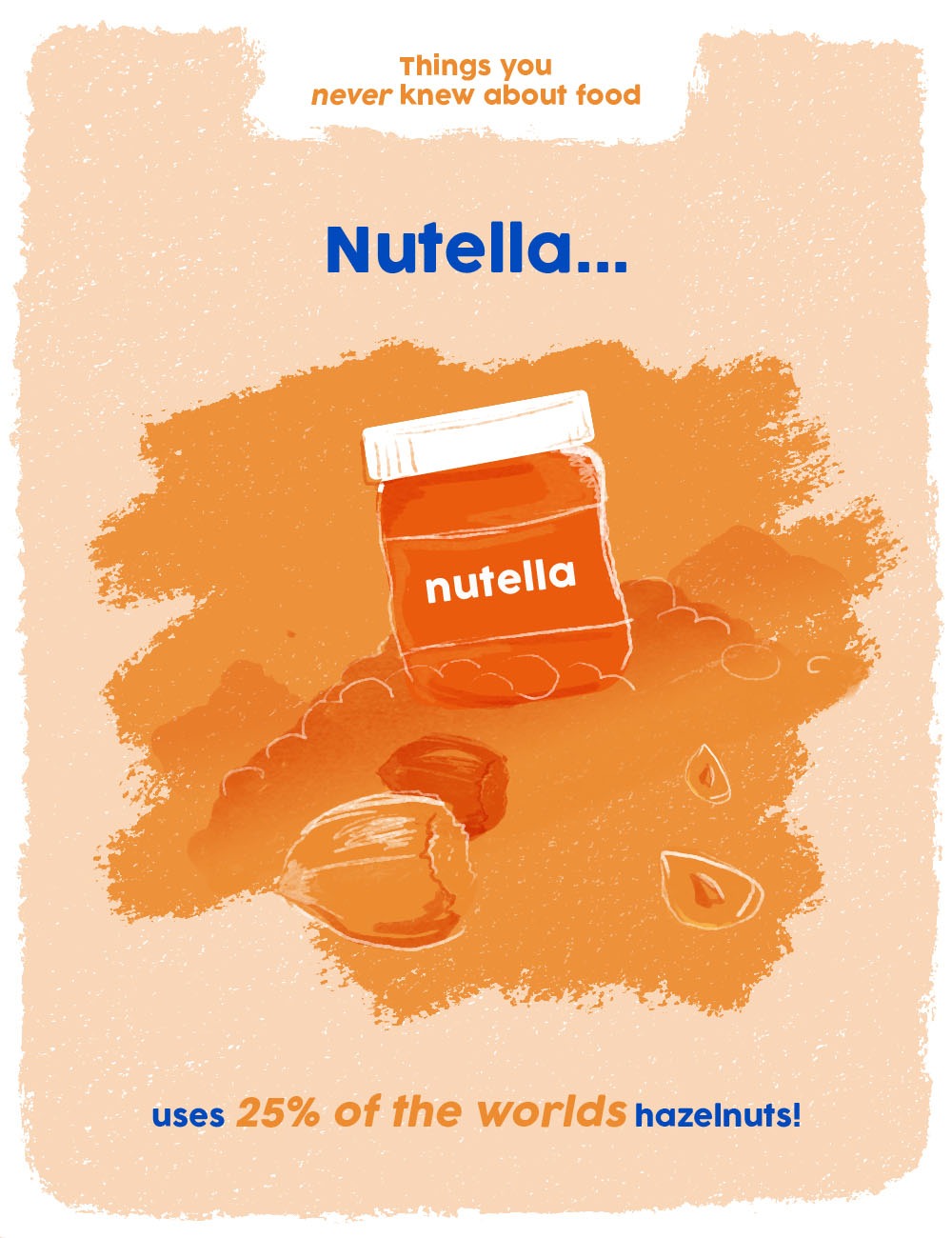
‘Nutella uses 25% of the world’s hazelnuts’
Nutella was an unexpected by-product of WWII. Italian chocolate-maker, Ferrero, couldn’t get enough cocoa, so he was forced to use hazelnuts instead. The result soon swept the nation and eventually the world. Nutella is now infallible, global brand, and as a result, they use a quarter of the world’s hazelnuts.
So where do Nutella get their hazelnuts from? Hazelnut trees used to mostly grow in Turkey near the coast of the Black Sea. Turkish farmers would pick them by hand and were proud of their crops. However, the Turkish hazelnut farms aren’t impervious to bad weather causing bad harvests which can result in global hazelnut shortages.
Hazelnuts are now grown in places like Australia, Chile and even in university labs in climates where they would not survive. That’s right folks, the global demand for Nutella is so big that universities are trying to grow hazelnuts in labs so we can never run out, and we would like to thank them for being so considerate.
Fun Interesting Facts

‘Until 2011, Russia classed beer and any alcoholic beverages under 10% ABV as soft drinks!’
That’s right, Russia didn’t consider beer to be alcohol until 2011. Vodka has long been the traditional tipple of Russia but beer began to make some headway. It was advertised as a healthy alternative to spirits, it was cheap and it was barely regulated as before 2011, it was seen as a foodstuff. Legislation was introduced to classify beer as an alcoholic beverage and to limit when and where you can sell it.
Russians are consistently in the top five heaviest drinkers in the world and this legislation was introduced to address Russia’s serious drinking problem. Beer not being recognised as alcohol meant that it was being drunk freely everywhere and anywhere. The spectres of alcoholism and underage drinking became too much of a problem to bear and Russia has clamped down on drinking especially as it appears to have stunted their population growth. It’s estimated that 500,000 Russians die every year from alcohol-related reasons. Make sure you drink responsibly.

‘Cheese is the most stolen food in the world’
If you can believe it, the most stolen food in the world is cheese. 4% of ALL cheese gets stolen. But what are the motives? Well, it turns out that cheese isn’t just being stolen from people trying to survive but is also being stolen to be resold. That’s right, cheese is so damn tasty that there’s an entire black market of lifted cheeses.
As cheese is so popular we thought we’d share some more surprising cheese facts. There is a bank in Italy that will take parmesan cheese in exchange for cheap loans and then pay you a fee if it matures well. You might think that’s some weird archaic loophole in the bank’s practices but no, they have around 200 million dollars’ worth of parmesan cheese in their vaults.
Charles de Gaulle remarked about his beloved France, “How can anyone govern a nation that has 246 different kinds of cheese?”. The French love their cheese and Charles would be shocked to find out that some experts estimate that France now has around 1000 different varieties of cheese.
And finally, if you’re going to steal some cheese…which you shouldn’t…you might want to make a beeline for the moose cheese. Moose cheese costs around £150 per kg as milking a moose takes around two hours and has to be done in complete silence.

‘There’s be no chocolate if there were no flies!’
What would happen if we ran out of chocolate? Well, that’s a possibility we don’t even want to think about. But what if we told you that chocolate was made possible by a secret force and without them, this is a scenario we could face?
That’s right, there is a secret force of quiet superheroes working tirelessly to make sure we can get our chocolate and they are…a species of microscopic midge. A bit anticlimactic, but there two kinds of midge that fertilise and pollinate the cacao trees that we so rely on. This allows for the cacao tree to stay alive, grow cacao pods and spread its seeds.
The two types are called Euprojannisi and ForcipomyiaI, but we shall refer to them as ‘The Chocolate League’. These silent heroes have been providing us all with a service, one that we won’t forget. We salute you, Chocolate League.
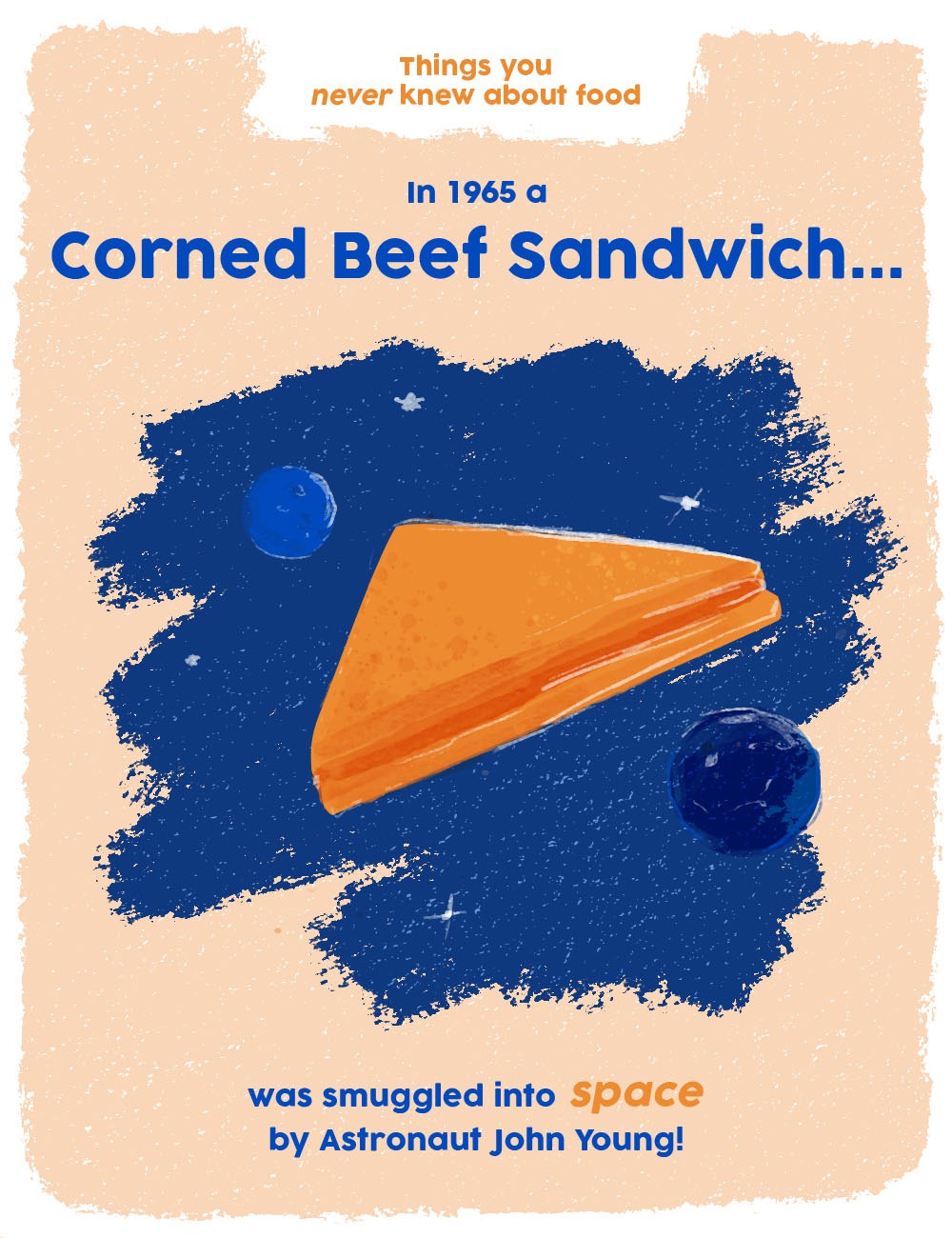
‘In 1965 a corned beef sandwich was smuggled into space by astronaut John Young’
A corned beef sandwich has been to space, just let that sink in. Here’s the story detailing how a corned beef sandwich became a stowaway on a US space mission in 1965.
In the 60s, space agencies hadn’t really figured out the whole space food thing. Meals would often consist of ‘nutrition pouches’ that you would have to suck. Naturally, if you’ve been sucking on nutrition pouches, the need for a proper sandwich is going to take hold.
Astronaut John Young took matters into his hands, literally, by taking a corned beef sandwich aboard his spaceship in his pocket. Before we go any further, he wasn’t about to live on the International Space Station for a few months, it was a six-hour mission. He tried to enjoy said sandwich and discovered it was breaking up in the zero-gravity conditions pretty quickly. He stuffed it back into his pocket, for his co-pilot to remark that it was a good thought, if the sandwich would’ve just held together.
We can confirm that NASA have “taken steps to prevent recurrence of corned-beef sandwiches in future flights”. That was a legitimate quote from a NASA spokesman.
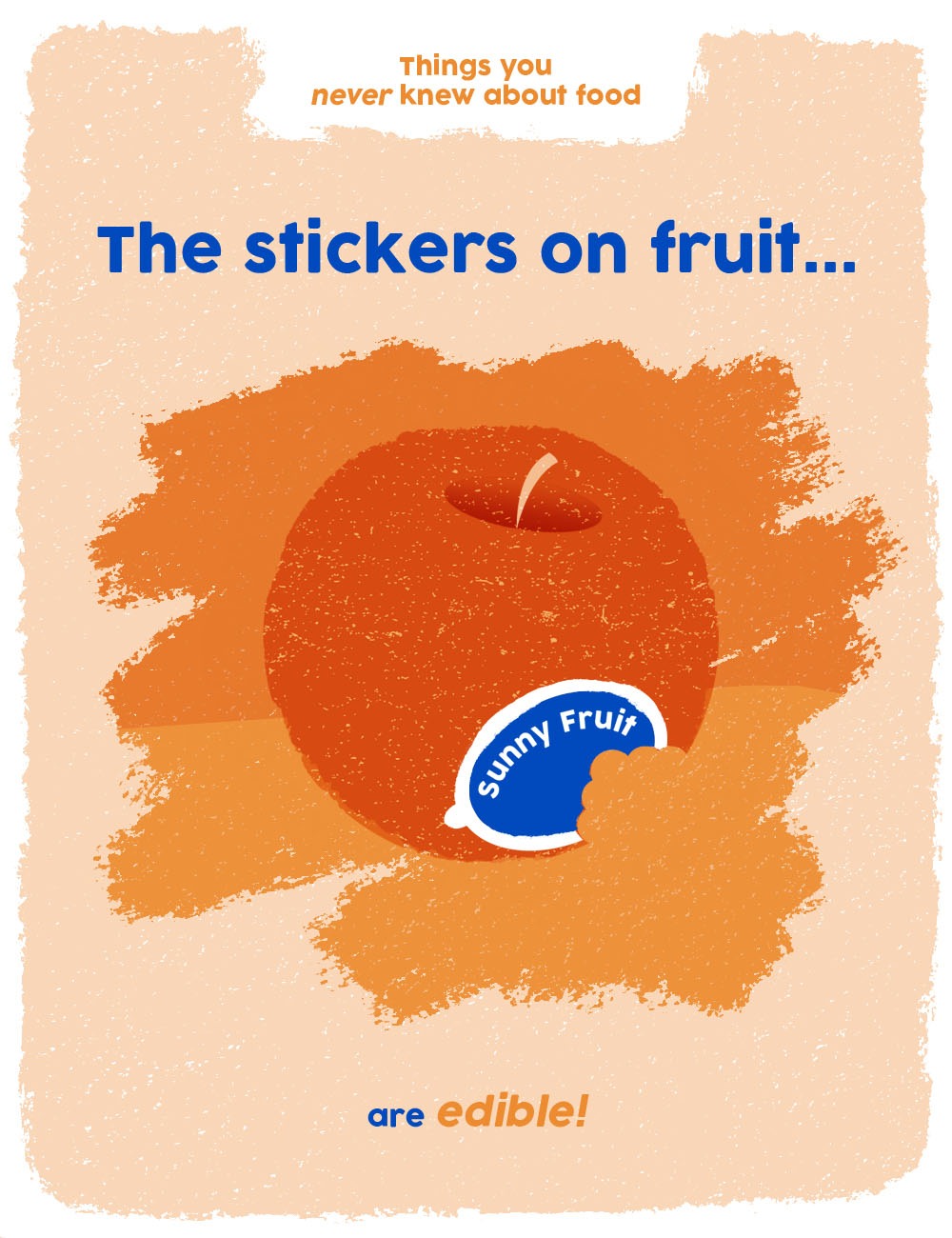
‘The stickers on fruit are edible!’
It’s a mistake that is made all too often. Eager to get stuck into your food, you’ve ended up taking a bite out of the sticker. If you’ve worked yourself up into a frenzy because you think you’ve ingested some highly toxic adhesive then don’t worry, this fruit fact is going to quell your worries. Fruit stickers are in fact edible and non-toxic. Let’s be clear though, they’re non-toxic but they’re still probably not good for you, so don’t treat this as a cue to now just eat every fruit sticker you come across.
Fruit stickers may even become a thing of the past as supermarkets may begin to follow Sweden’s lead in marking their fruit and veg with lasers to reduce unnecessary waste.
Fast Food Facts
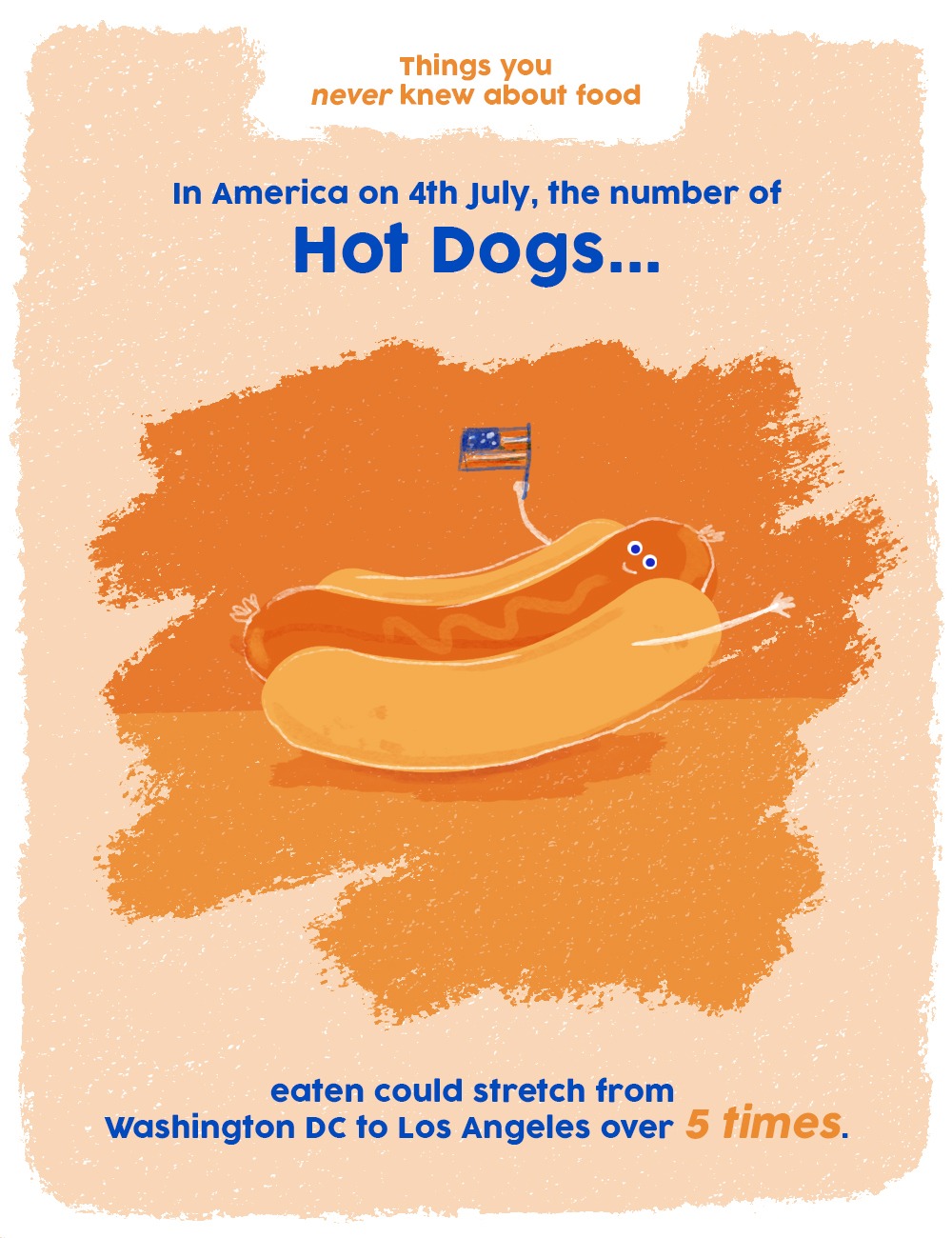
‘In America on 4th July, the amount of hot dogs eaten could stretch from Washington DC to Los Angeles over 5 times’
In America, our transatlantic cousins celebrate their independence. 4th of July celebrations in America are marked with cookouts, fireworks and good old-fashioned gluttony.
The peak ‘hot dog season’ in America lasts from the end of May to the start of September. During this period of reverence to the sausage gods, around 7 billion hot dogs are consumed. That’s 818 hot dogs a second.
We got these stats from America’s National Hot Dog and Sausage Council. Not joking, that’s a real thing. You can go and work for them. You can get paid to track the hot dog and sausage eating habits of America. Considering the amount of hot dogs that they eat on the 4th of July can stretch across the country over 5 times, that job is probably much harder than it sounds.
McDonald’s Facts
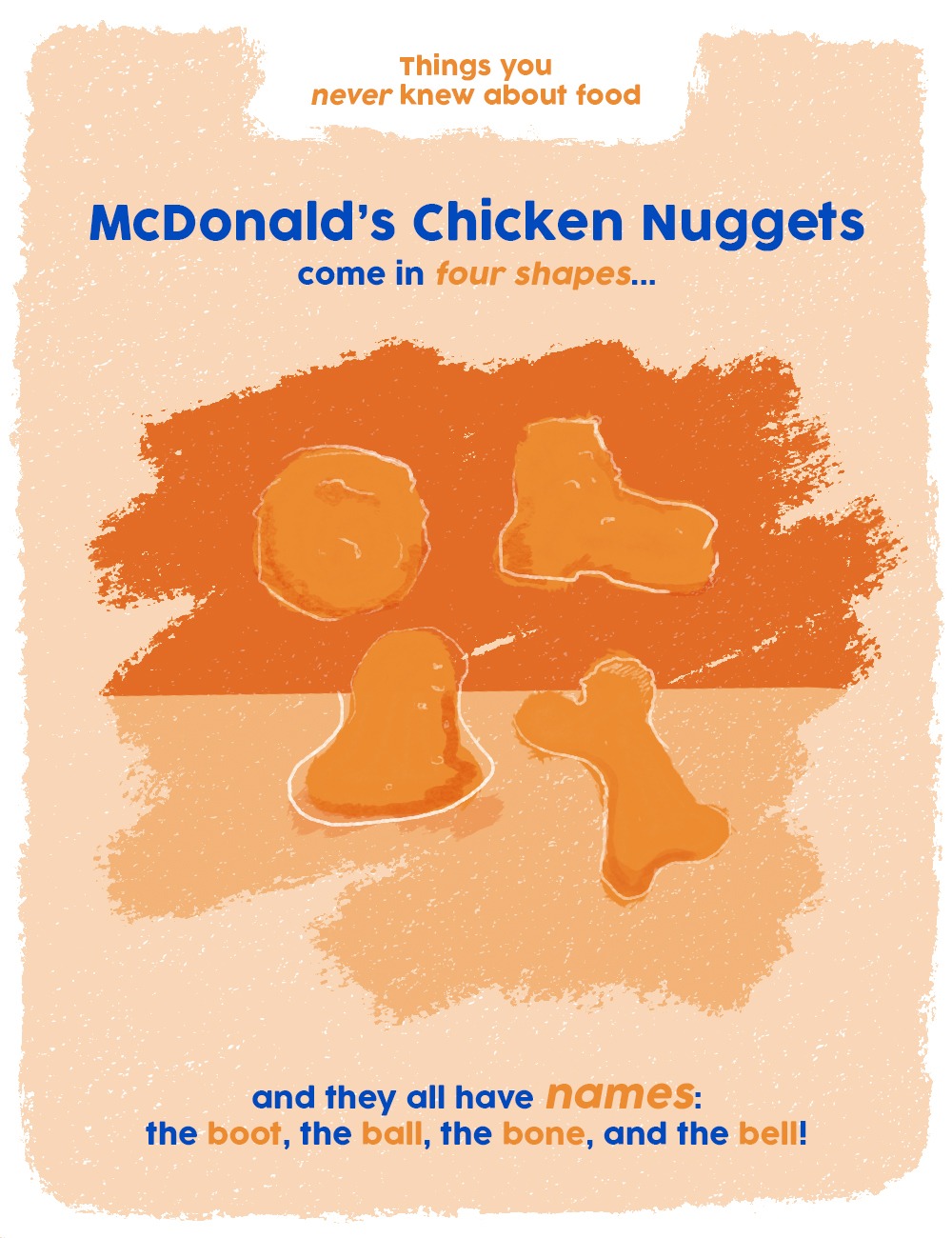
‘McDonald’s chicken nuggets come in four shapes and they all have names: the boot, the ball, the bone and the bell.’
You’ve probably never given much thought about the shape of a McDonald’s chicken nugget, we tend to reserve our thought process to ‘how are these so good’ and ‘can i really make it through a box of 20 nuggets’.
Turns out there’s actually an art to how McDonald’s make their chicken nuggets though. Your nuggets will always be one of four shapes: the bone, the boot, the bell and the ball. The nuggets are cut into these shapes with what are essentially cookie cutters, before being battered and frozen.
McDonald’s, when questioned on this, said: “Three would’ve been too few. Five would’ve been, like, wacky”. We’re not sure what experiments and testing went into this but hey, we’re not going to argue with McDonald’s and their presumable armies of chicken nugget scientists. They’ve said that these shapes are geared towards children, to ensure consistent cooking and for extra ‘dip-ability’. There’s an interesting fast food fact for you to keep an eye out for next time you’re enjoying some McNuggets, if you’re one of those people that actually look at the shape of the nugget before scoffing it.
*There’s no proof that the shape of the nugget has any effect on the taste.
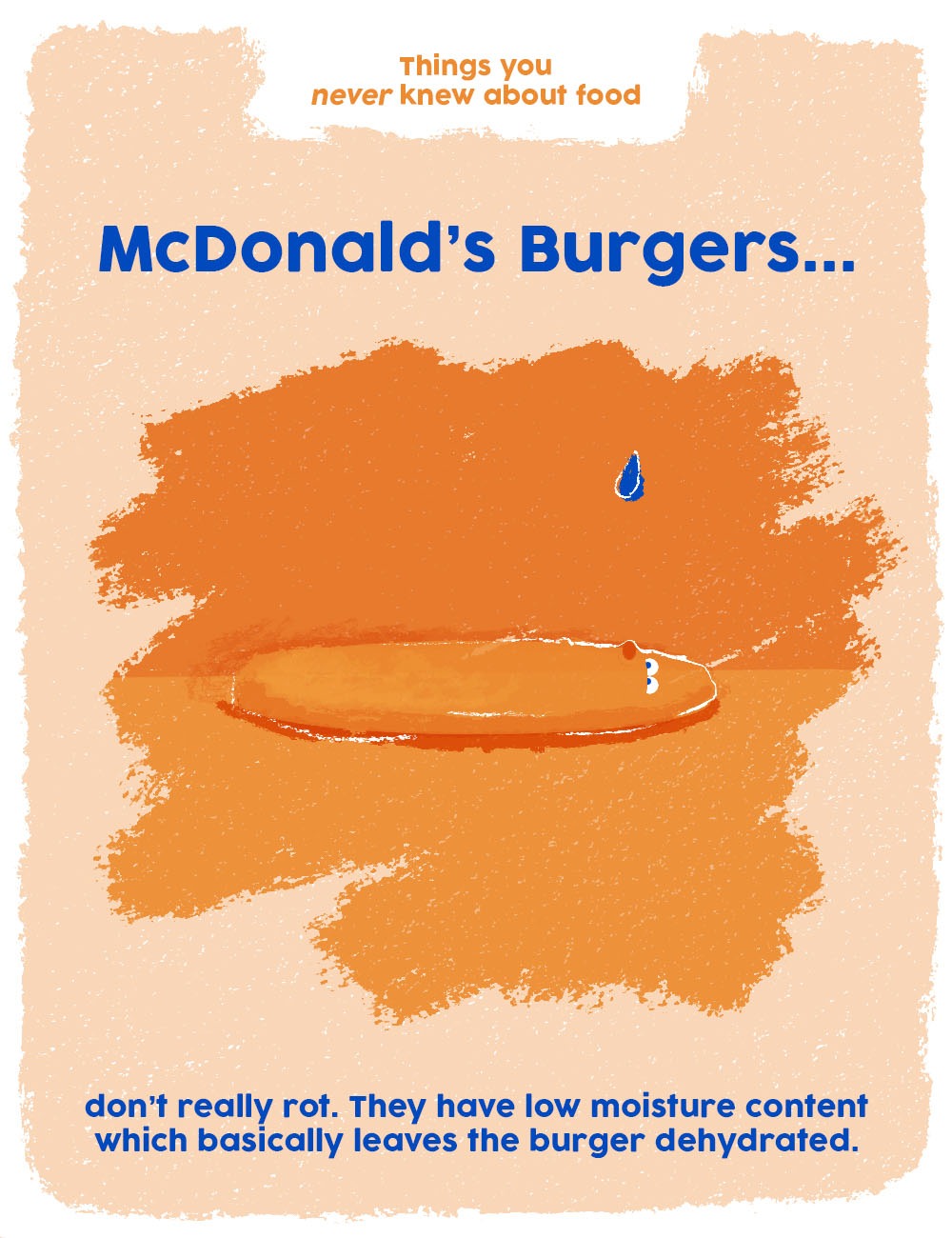
‘McDonald’s Burgers don’t really rot. They have low moisture content which basically leaves the burger dehydrated.’
This may not be news to you, pictures of 15-year old McDonald’s burgers have done the rounds on social media before to the usual outcry of disgust. The natural conclusion that people jump to is that McDonald’s lather their burgers with preservatives or that there is too much salt.
There has been some rigorous independent testing of the matter and the conclusion appears to be that the surface area of the burger means it loses moisture very fast. Mould can’t grow without moisture and so it just becomes akin to jerky. It’s actually through this process that beef jerky is made, so no need to be alarmed, it’s science. Still, there’s something not right about seeing a picture of a 15-year old McDonald’s and it looks like one that’s an hour old.
Food Science Facts
‘Loud music can make you drink more, and faster!
A study undertaken in France has shown that loud music in a bar often lead to people drinking quicker and faster. Conducting the study on forty young males between the age of 18 and 25, they found that when the music was louder, their subjects drank quicker.
From this they have deducted that loud music may have caused higher arousal, resulting in the subjects buying more drinks. Another conclusion was that louder music made it harder to socialise and drinking more is a response.
You might be thinking that is an obvious conclusion. If you crank up the music at a bar, people drink more, that’s not really a shock. The study was conducted to show the effect our surroundings can have on our behaviour however and to highlight that bar proprietors should try to instil an atmosphere that doesn’t promote heavy drinking.

‘Peanut butter can be used to make diamonds’
You might have millions of pounds worth of diamonds sitting in your cupboards! If you’ve got peanut butter, you can turn them into diamonds. What’s the catch? You need to be able to replicate the conditions of the Earth’s lower mantle…which is 2,200 degrees centigrade.
The core of Earth is around 4,000 miles below us and yet we have only managed to dig 7 miles in to the Earth’s crust. There’s lots of questions about our inner planet that haven’t been answered yet. Scientists have been trying to recreate these conditions to find out more about the workings of the world and needed a carbon-rich material and landed on peanut butter. Don’t get too excited, it took them weeks to create a 2mm diamond.
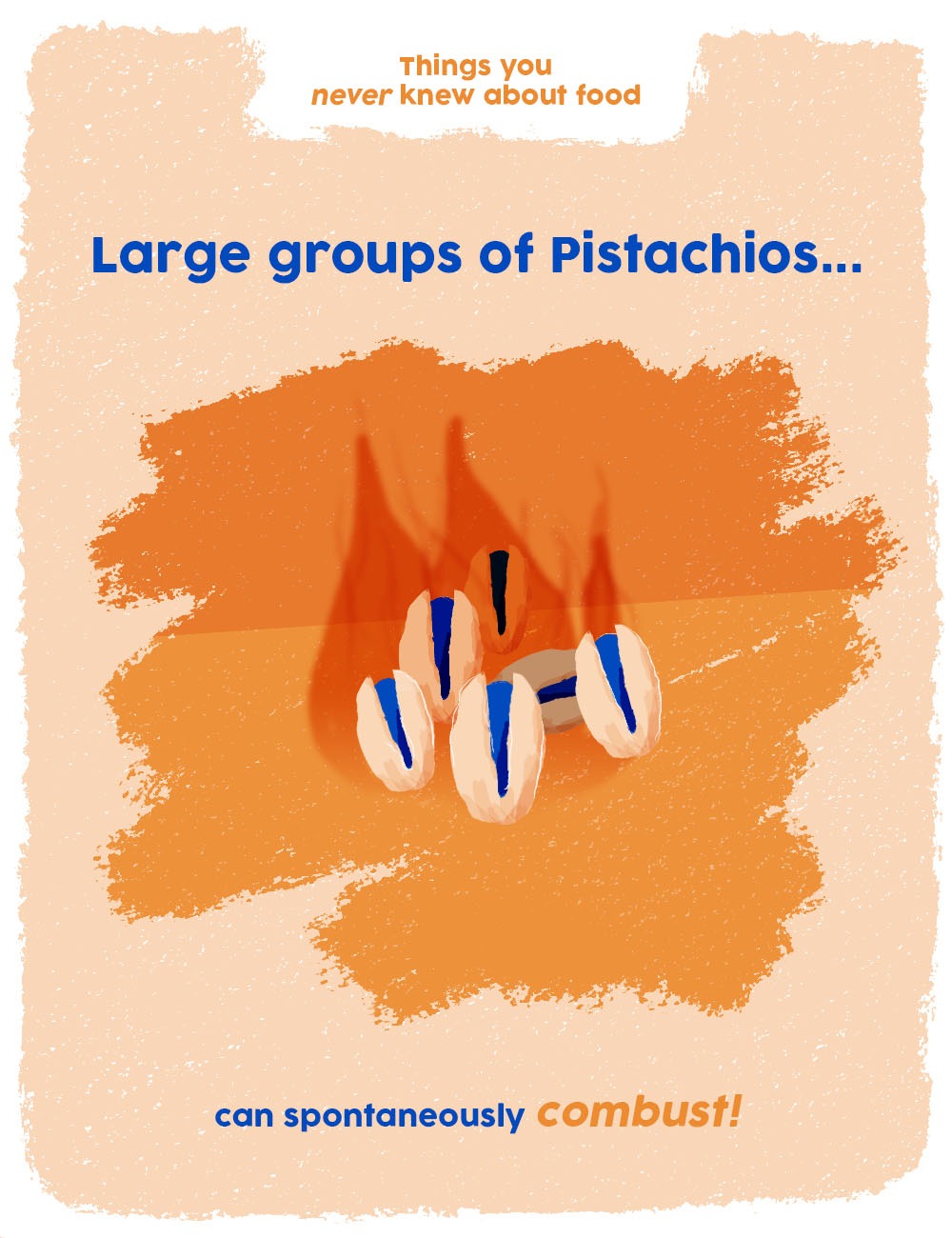
‘Large groups of pistachios can spontaneously combust’
Spontaneous combustion is a really nice way of saying ‘suddenly in flames’. Due to their low water and high fat content, pistachios have been known to burst out in flames. We’ve all seen temper tantrums before, but this seems a bit much. In seriousness, the nuts and its kernels can overheat when stored in the oily fibrous materials used for its transportation.
There have been urban legends of humans that have spontaneously combusted and those kinds of cases only tend to exist on paranormal TV shows. Just be wary any time you pass a huge mound of pistachio nuts.

‘You can hear rhubarb grow!’
Rhubarb has been flying under the radar for a while now. It’s a humble plant, tends to stay out of the press, minds its own business. But did you know, that you can literally hear it grow? During a process known as ‘rhubarb forcing’, you will hear a cacophony of pops as the rhubarb grows.
The process began in Northern England in the 19th Century. You put the rhubarb into a dark shed, halting photosynthesis and essentially trick the plant into thinking its spring. The rhubarb will grow unnaturally large and at fast speeds. It feels quite wrong when you think about it, all that rhubarb in a dark shed, screaming out as it grows unnaturally large. But then again, it is a plant.
Food Origins
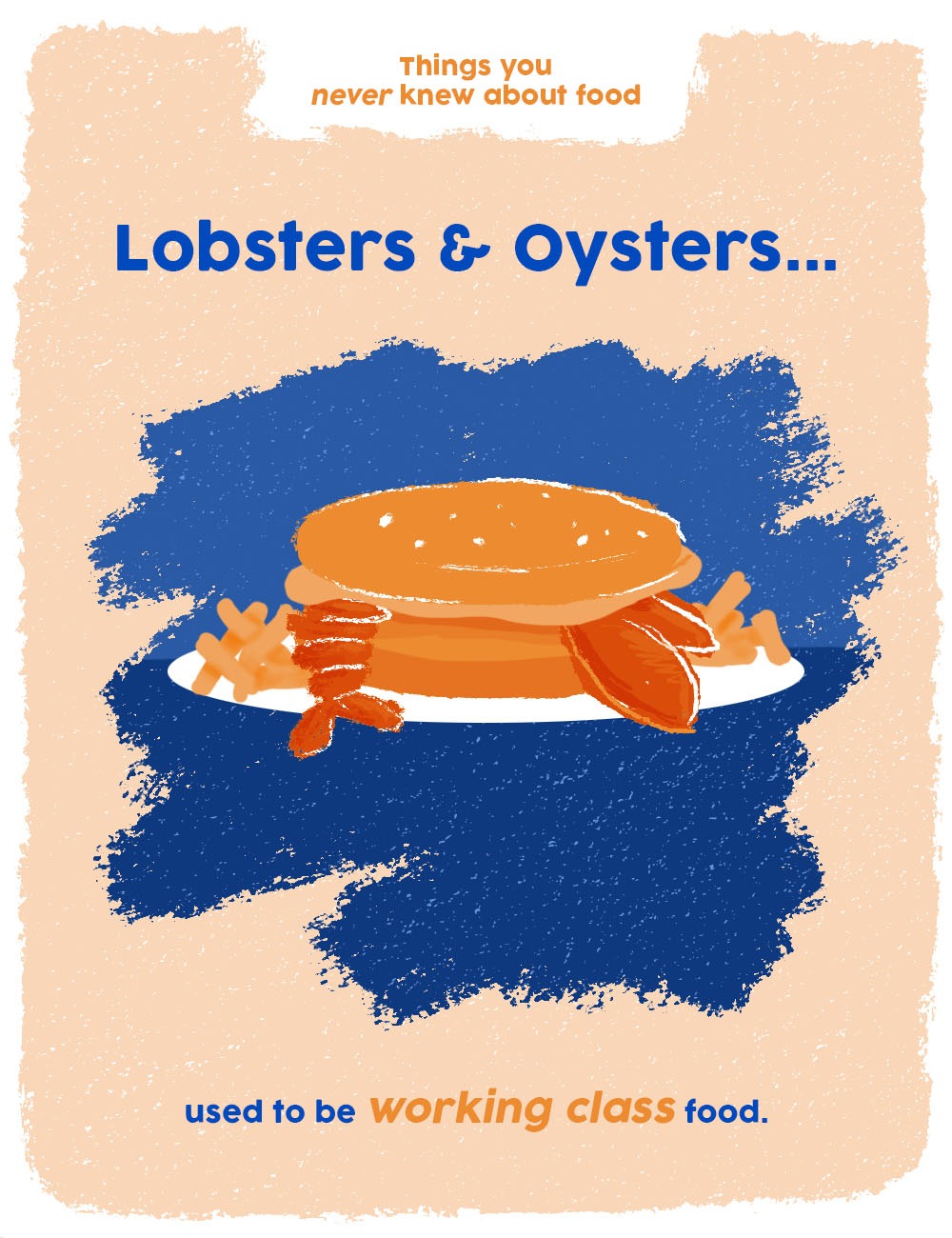
‘Lobsters & Oysters used to be working class food’
Lobsters have come to be the height of sophistication. It’s on the menu in every posh restaurant in the world. But that wasn’t always the case and at one time lobster and oysters were barely worth putting on your plate.
The lobster is quite literally a sea insect and they don’t look particularly appealing either. Back in the day, lobsters would get caught up in a fisherman’s net and they would often get tossed back in or given to servants to eat. Oysters had a similar rap, not only are they hard to harvest, but they’re not that nutritious. They had been relegated to scraps for the working class. Lobster was the equivalent of rat meat and some US states even had laws on how much lobster you could feed to a prisoner as too much was considered cruel.
In a cruel twist of irony, lobster is now one of the most requested last meals on death row. Some shrewd marketing and in the oysters’ case, some dreadful conservation, has led to a rise in popularity and price of these foods.
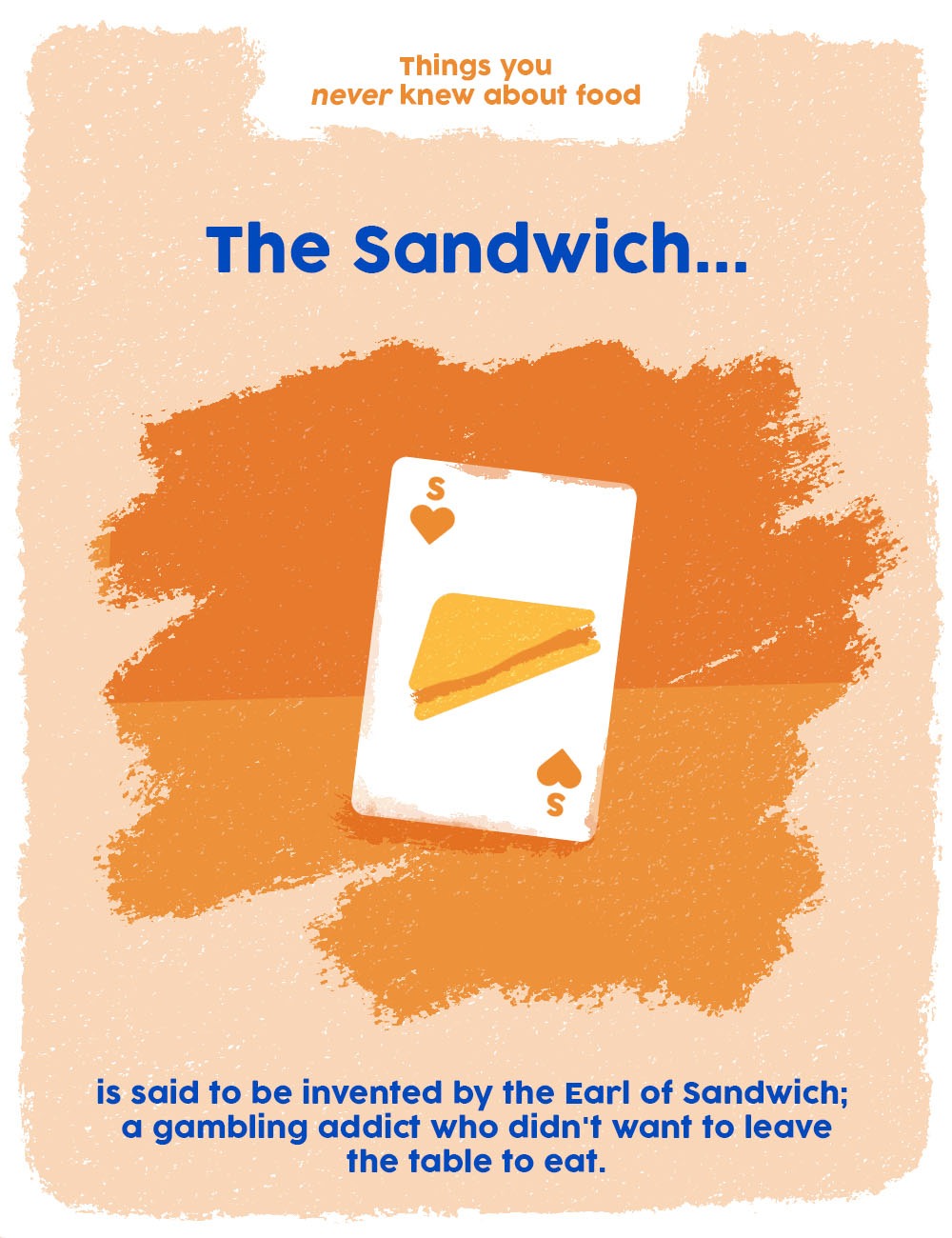
‘The Sandwich is said to be invented by the Earl of Sandwich; a gambling addict who didn’t want to leave the table to eat.’
Imagine being the inventor of the sandwich. Imagine having that as your legacy. Well here’s what happened. The legend goes that the 4th Earl of Sandwich, John Montagu, was in the midst of a 24-hour gambling streak. He required some food, but he couldn’t put down the cards. Naturally, as an Earl, he asked for someone to get him some food that wouldn’t disturb the game.
Now, we don’t know if John Montagu’s cook had already conceived the idea of putting some meat in between two slices of bread and was just waiting for the right opportunity to wheel out his daring new take on lunch. We don’t know if this request from the Earl sent his whole kitchen team into a frenzy and it took them hours to create a solution. We’ll also never know who actually created that first sandwich as it was named after the parish it was conceived in. I bet you didn’t think the first sandwich was shrouded in such mystery, but it is.
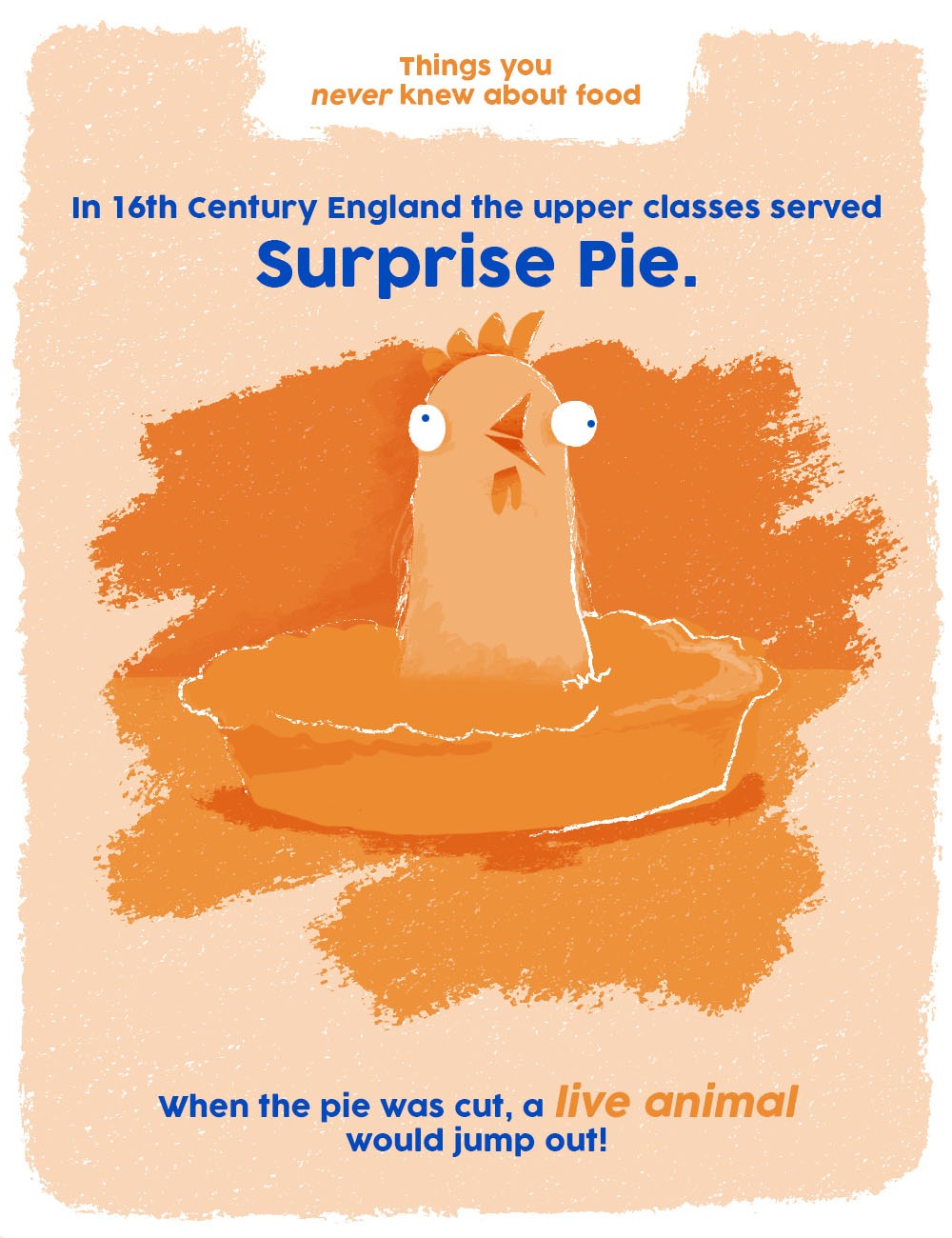
‘In 16th Century England, the upper classes served Surprise Pie. When the pie was cut, a live animal would jump out!’
16th Century England was a weird time. Whilst da Vinci was designing a helicopter, Henry VIII was collecting wives, and frankly you’d a good and long life if you made it past 30 years old. Let us tell you about how the English upper classes decided to put a spin on dinner entertainment.
At this point, pretty much all food was encased in pastry if not being eaten there and then. The crust of pie was originally packaging, to be thrown away. So, pies were pretty widespread. The upper classes were known to break out a ‘surprise pie’. You would start to dig in, only for a live animal to jump out of the pie.
It has been indicated that some of the animals that have gone into these surprise pies include foxes, squirrels and frogs. Was it a practical joke? Were you supposed to catch the animal and eat it? Who knows? it was the 16th Century, Henry VIII was on his sixth wife and they were burning witches, people had more to worry about than a frog in their pie. Which is probably why the joke always worked.

‘In the Middle Ages, black pepper was a luxury and was so expensive, it would be used to pay rent and taxes!’
It’s hard to believe that so much of the food we eat now, products that can be bought cheaply and are readily available at most stores, used to come at such a high premium. Pepper was a luxurious spice that had often travelled from faraway places like India. As a result, pepper and other spices would only be enjoyed by wealthy nobles.
Food in the Middle Ages was considerably different. A nobleman’s diet back then would consist of a variety of meats and game, fish, spices, cheese, fruits and vegetables. It was believed that raw fruit and vegetables contained disease so these always had to be cooked. Even for nobles, vegetables were a rarity. A peasant’s diet was even worse. An estimated 85% of the population were peasants in the Middle Ages and they would typically eat bread, porridge and meat stew.
But yes, pepper was so expensive back then that you could use it as currency. Italy had a monopoly on the pepper trade and it was so lucrative that Portugal sent an explorer to get some. Vasco de Gama became the first person to sail around Africa to get to India, all in the pursuit of pepper.

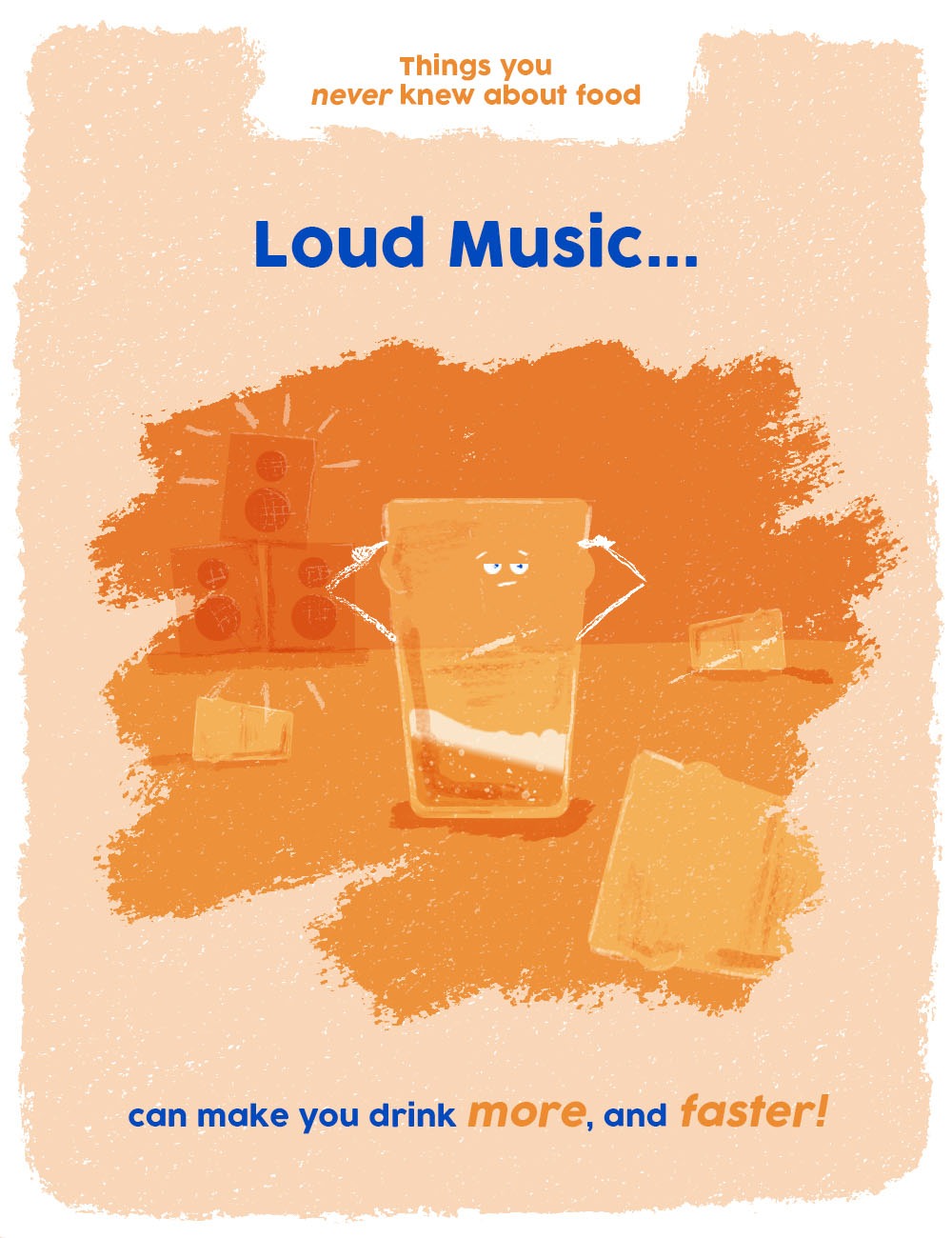
15 thoughts on “Things You Never Knew About Food”